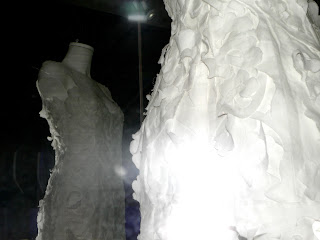Trash Fashion: Designing Out of Waste
Nowadays, ‘we’re buying a third more clothing then we did a decade ago’. The tailoring methods as well as the chemicals used and many other factors affect today’s environment. In this exhibition, designers are trying to promote the creation of clothing without waste by exploring the latest approaches and techniques.
New dyeing technologies (no use of water at all), tricks of light (material: morphotex -instead of dyeing), different tailoring methods, and biocouture, are some of the numerous techniques displayed.
This exhibition not only made me realize the damages even fashion has on the environment, but also enlightened me about the technologies discovered and developed during the past years to reduce the negative impacts on the environment.
Easier Recycling
The use of just one type of fiber makes any fabric much easier to recycle.
Kate Goldsworthy experiments here on a 100% polyester fabric using harmless chemicals and laser beams to cut into the fabric and create a pattern.
Sugar-made plastics
Polyester clothing is made out of oil, which is a non-renewable resource that is running out. ‘Ingeo’ –a bio-plastic called polylactic acid, produced by plant sugar- corn, wheat, sugar cane…- instead of oil.
Unlike oil, plant sources are renewable, and can be produced really quickly giving it a great advantage for the environment.
Bio-Couture
‘Cotton is the thirstiest fabric on the planet – 210,000 billion liters of water is used in its production each year.’ which harms the environment as well as the human’s health.
This is why Susanne Lee, a researcher at Central Saint Martins, started designing the bio-couture line of clothing. This concept consists of creating cellulose out of tiny bacteria grown in bathtubs of sweet green tea.
Although this technique appears to be a perfect option, it is still not in use. The material absorbs water and can break down really easily.
Challenge of Materials
Tantalum








No comments:
Post a Comment